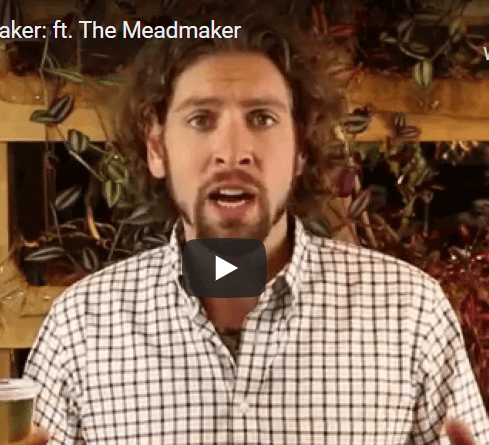In which Ricky the Meadmaker answers questions about nutrient additions, degassing, mead that won’t stop bubbling, cacao nibs, making mead without pasteurization, and more!
Your First Batch of Mead
As many of you may know, I am now temporarily the head brewer for Havoc Mead, as well as the head Brewer for Groennfell Meadery, what you may not know is that I am now contractually obligated to wear a beanie, have a stupid mustache, and wear exclusively shirts I've gotten for free.
Welcome to Ask the Meadmaker, where I, Ricky the Meadmaker, answer your questions about mead making, mead drinking, mead brewing, and really any question you're willing to send to me.
I'm going to start off with a very exciting question this week. It comes from Matt. As you know, almost every week I receive a question from someone whose mead has stopped fermenting. They wanted to keep going, it has too much sugar left, and they want more alcohol, but not Matt. Matt has the opposite problem. Matt wants his mead to stop. It was supposed to be a quick mead. It was supposed to be done in a few weeks, and it's been two months, and the bubbling will not stop. He is turning Campden tablet after Camden tablet and the yeast won't die. What should he do? The answer is, first of all, why is it still fermenting? If it's a low alcohol mead that should be done in three weeks, it's either an unbelievably slow fermentation, like it's too cold. Or possibly you're running into a problem where you didn't have a really good start. So, it's just slowly chugging along. But all that bubbling you see, depending on how vigorous it is, might not be fermentation at all. It might be a process known as off-gassing, where the bubbles that got trapped in solution during the fermentation are slowly coming out. So, you might not have a problem at all. How exciting is that?
Tom has a follow up question. A few days ago, or weeks ago, or months ago, how often do I do this show? Tom had a question about cocoa, adding cocoa to mead, and he wanted to know, as a follow up, how much cocoa nib would I recommend adding to a five-gallon batch and the answer is, I don't know. It's your mead, man! Throw cocoa in and tell me how it is.
We continue working our way through Li's numerous questions. This week's question, How often would I de-gas my mead? Now, de-gassing may be what you think it is if you think that it's removing the bubbles from mead during active fermentation. It is not what you think it is if you think that it's a fart joke waiting to happen, though it's kind of that too. Anyway, degassing is done to promote vigorous fermentations because the CO2, as it stays in solution, retards fermentation. The problem is if you degas too often, you risk hurting your mead. You risk adding oxygen when you don't want it, and worst of all, you risk introducing buggies. Things from the air. Every time you open your mead, there is a risk. So, the answer is don't de-gas too often, if you feel obligated to do it at all.
Jerry does not like to heat his raw honey, which is probably wise. Why would you spend a lot of money on volatile compounds and raw honey and then just boil them away? But I presume he also doesn't like to sulfite, which is fine, a personal choice. His problem? He wants to have a good mead and he wants to know if he just pitches massive amounts of yeast, what are the chances that the wild yeast in the honey will negatively impact his mead? The risk is there, Jerry. But with substantial pitching of a cultivated strain, drying it to the bone, chances are pretty good that your pitched yeast is going to win.
So, apparently there's a video out there of my homebrew conference lecture, which I did not know about. So, sorry about anything I might have said which is now indelibly on tape. Because, frankly, I have no idea what I said. Scott watched the whole video and reminded me that I said something about how I pre-pitch all of my nutrients. I don't stagger my nutrients. Now, the internet is full of advice to stagger your nutrients. And I feel, and I have an article coming out soon, that this is misguided because it's a misunderstanding of the yeast life cycle. But he wanted to know if I moved to pressure oxygenation and to pre-pitching my nutrient, if that's what we want to call it for any good reason, other than the fact that it's a pain to pitch nutrient every few days and open up your fermenter. Now, I already told Li earlier in this episode that every time you open your fermenter, there is a risk. So, that's one reason not to stagger your nutrient. And the other is it's a pain. If you can get away without doing it, I don't know why you would do the extra work. That's your answer, Scott. And also our last question of the week. I just need to send it over to Ricky with our word of the week. Ricky?
Thank you, Ricky. This week's term is off-gassing. Now, when you Google "off-gassing," what you'll find is volatilization of organic compounds. That is not the type of off-gassing we're discussing. Off-gassing in mead and other fermented beverages is when bubbles that are trapped come out of solution. Normally, off-gassing, also known as out-gassing, is when potentially toxic chemicals come out of things like upholstery and carpets and the walls. That is very, very different. Here's the thing I hate about the internet. When you Google off-gassing, the first thing that comes up is how scared should I be? I think this says a lot about modern society.
Off-gassing. It's our word of the week at the end of our show. Keep sending your questions and I'll get to them as soon as possible. Cheers.




